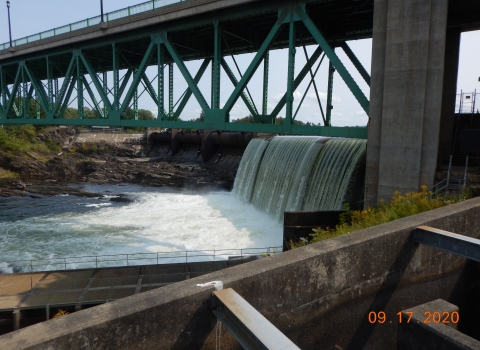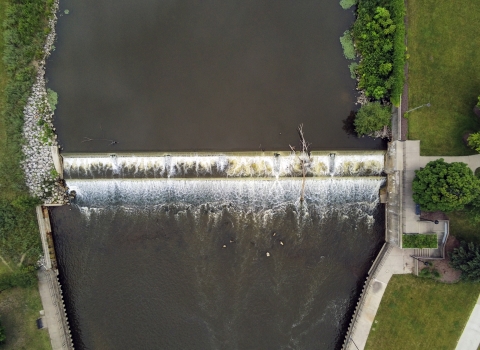More than half a million dams block our nation’s rivers, and many are nearly invisible. Underneath their murky waters, they halt the free flow and exchange of fish, nutrients and sediments, and they pose a deadly risk to recreationists and families across the country. We at the U.S. Fish and Wildlife Service are dedicated to removing those dams that are unsafe, negatively impact the environment and serve no modern-day purpose. Read on to learn what dams do, what targets a dam for removal and who may be affected by their removal.
What exactly is the function of a dam?
The dams we are most familiar with are large structures built with specific purposes in mind such as to generate power, reduce flooding, move ships and even contain toxic waste. Massively engineered structures, like the Hoover Dam, provide drinking and irrigation water to millions of people. With climate and precipitation patterns becoming increasingly erratic, these dams save lives. But not all dams are were made with equal forethought or planning. Without continued maintenance, most dams in the nation are now failing - these are the dams we need to address.
The average dam in the U.S. is 57 years old and ready for retirement. The vast majority are small, locally or privately owned and were originally built to control water flow, mill grains, transport lumber or create a reliable fishing spot. Thousands of these dams have begun to degrade inside of our rivers, harming aquatic, terrestrial and human life. Though they are championed as a source of renewable energy, less than 3% of dams in the U.S. are still used to generate energy. Nowadays, the main purpose of most dams is to create open water for recreation activities like fishing and swimming.
A dam large impact to people and economies
Dozens of lives are lost to dams in the U.S. each year, and as their purpose and stability disappears, 49 states have already implemented dam safety programs. Missouri, Texas and North Carolina each have more than 1,000 dams considered as being likely to take human life should failure or mis-operation occur.
Dams alter the flow, chemistry, silt load and temperature of water. Furthermore, by changing the silt deposition on the bottom of the riverbed, it has even been suggested that dams may lessen the volume capacity of rivers and actually increase flooding downstream. Dams also disturb wetlands. Wetlands are the world’s most powerful water-filtration system, but they have a notoriously delicate disposition. Wetlands provide New York City with its famed tap water, which is argued to be the best-tasting in country and yet never enters a filtration plant. Half the population of New York city depends on wetlands to clean their water, and the entire city saves money by avoiding construction and maintenance of large filtration facilities. Wetlands are truly one of the most underrecognized, productive and diverse habitats in the world.
Damming our rivers, damming our fish
Dams, whether old or new, impact the entire ecological system. When a river is dammed, so are the nutrients and animals inside of it. This interrupts the life cycles of numerous aquatic species and subsequently, disrupts the food web. Dams slow the natural flow of water and warm it, promoting the spread of deadly algae and parasites. Effects like these have already caused extinction for many species of mussels, fish and even a dolphin. Dams have been harming salmon and sturgeon since their installation, and people are frustrated to see these culturally and economically important species hurt when it is within our ability to protect them.
Our agency has an entire program dedicated to opening up rivers for fish passage fish passage
Fish passage is the ability of fish or other aquatic species to move freely throughout their life to find food, reproduce, and complete their natural migration cycles. Millions of barriers to fish passage across the country are fragmenting habitat and leading to species declines. The U.S. Fish and Wildlife Service's National Fish Passage Program is working to reconnect watersheds to benefit both wildlife and people.
Learn more about fish passage . Fish passage refers to the movement of fish up and down rivers to reach spawning and feeding places. Much like birds and butterflies, fish need to move. But since we can’t easily see fish, or other the organisms traveling within rivers, many people don’t understand how problematic dams are to an aquatic ecosystem. For example, sturgeon and salmon both remember where they were born and will return from great distances to that exact location to lay eggs once more, participating in a species-long tradition. Improving fish passage is one of the most effective ways to help conserve vulnerable species while building safer infrastructure for communities and improving climate resilience.
Learn more about how we’re improving the migration of fish in North America’s waterways.
Considering communities and invasive species invasive species
An invasive species is any plant or animal that has spread or been introduced into a new area where they are, or could, cause harm to the environment, economy, or human, animal, or plant health. Their unwelcome presence can destroy ecosystems and cost millions of dollars.
Learn more about invasive species
Though dams can negatively impact the environment, they can also be cherished by their communities and aid in the control of invasive species. Many communities appreciate their local dams because of their historical and cultural significance. Dams can provide space for gathering and nature-appreciation. They also create reliable ponds of water for fishing that are often uniquely accessible.
When our agency removes a dam, we mimic the characteristics of a healthy and self-sustaining river by installing nature-based solutions. Tearing down a dam doesn’t mean losing a fishing hole. We fashion tree roots, boulder piles and more into the riverbed and riverbank. These methods copy nature’s way of creating pools and habitat for fish so that human communities not only maintain their favorite fishing hole but enjoy a wider diversity of species that will be healthier and live longer.
Along with the rest of aquatic life, aquatic invasive species have also been restricted by dams. Dams can protect larger watersheds by shielding them from invasive species. We value this protective quality provided by dams and prioritize maintaining those acting as the last barrier to the spread of invasive species, such as the sea lamprey.
Learn more about how protective barriers help keep invasive species from spreading.






